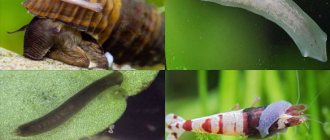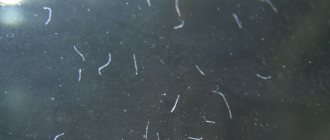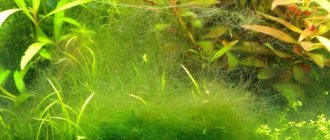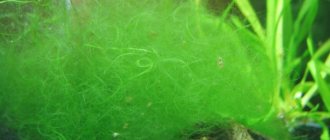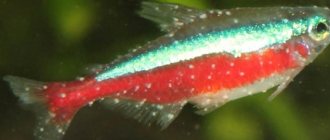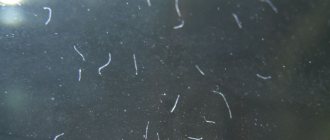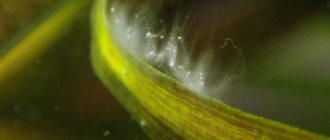An aquarium is a miniature world inhabited by decorative fish, shrimp, and snails. Flora lovers create a real underwater jungle in their home. It is important not only to know the compatibility of different species, but also to maintain it correctly, creating the necessary conditions.
Uninvited guests often appear among your beloved pets. Most of them are harmless, but still cause inconvenience and discomfort. The presence of parasites indicates a deterioration of the habitat, and this factor cannot be ignored. Planaria is one of the pests that settle in the aquarium.
Planaria - what is it?
Planariidae are a species of ciliated flatworms that live primarily in the soil and between plants. In nature there are marine, freshwater and terrestrial. There are white, brown and reddish. The size of the worms ranges from a few millimeters to 3.5 cm. The head is diamond-shaped and has eyes that determine the intensity of light. The mouth opening is located on the abdominal cavity. Oxygen saturation occurs throughout the entire surface of the body. The sense of smell is well developed.
Interestingly, digestion occurs outside the body: the worm secretes a special enzyme, thanks to which the food is ready for ingestion.
The skin glands contain poison that protects against enemies.
Usually the presence of pests becomes known when they crawl out of the ground en masse. This suggests that the conditions for them have become suboptimal (the composition of the water, the temperature have changed).
They are predominantly nocturnal, hiding in the ground from sunlight. Planaria are interesting when moving: they do not stretch, like other worms, and do not contract, but glide smoothly. It is not visible to the naked eye that they move this way with the help of hair. As they move, they secrete mucus that coats objects in the water. The eyelashes rest against it, pushing the body forward.
Anatomy and physiology: internal organs
Planarians do not have a body cavity. The organs are separated from each other by parenchymal tissue. Planaria lack a circulatory system, as well as a respiratory system. It receives oxygen diffusely through the integument of the body, and nutrients enter the cells directly from the intestines.
The digestive system is designed in a unique way. Of particular interest is the retractable pharynx, with the help of which the worm is able to grab prey. This structure of the digestive tract once again proves that planaria is not a parasite. Worms living in the body of another creature do not need to hunt. Their main task is to infiltrate an area where they can gain access to food and stay there. For this purpose they have special devices: hooks or suction cups.
The digestive system of planaria is not continuous, that is, it has one opening - the oral cavity. Through it food enters and waste products are eliminated. The excretory system is a network of tubes that pass through the entire body and open mainly on the back of the worm. Liquid wastes, including toxic compounds, are removed through them.
Internal structure of white planaria
The planarian nervous system is primitive. It is represented by paired nodes at the head end and trunks running along the body. Branches extend from them to the organs and outer integument, providing the sense of touch. There is an organ of balance. At the front end of the planaria body there are eyes that allow them to determine the degree of illumination. Around them there are formations with the help of which the worm detects movement and senses an obstacle that has arisen on the way. Planarians do not have a brain. However, even such a primitive structure surpasses in complexity the similar system of worms, which spend most of their lives in the body of another creature. The parasite does not need a developed nervous system or sensory organs.
Being a predator, the planaria has adaptations that allow it to detect and capture prey. Its digestive system is equipped with a retractable pharynx, and its senses help it navigate in space and detect movement.
Reproduction
They can reproduce in several ways.
Sexual
Worms are hermaphrodites. During intercourse, individuals exchange sex cells. The eggs, wrapped in a cocoon, are hatched. The eggs hatch into independent individuals. Eggs are not exposed to high temperatures, drought or chemical treatment. Also frost resistant.
Asexual
This method involves transverse division of the body. The worm is able to recover from a small part to its normal form. Thus, they spread at high speed in the aquarium.
Types of Planaria in the aquarium
There are more than a hundred species, two of them are most often found in the aquarium.
White
Dendrocoelum lacteum is a predatory worm that lives in fresh water bodies. Length 1-2 cm. They feed on small crustaceans, worms and the remains of large animals that live in water. They cause minimal harm in the aquarium.
Black
Polycelis nigra differs from white Planaria in its black or brown color. The size is no more than 1 cm, there are 30-50 eyes on the head, for which it is also called the black many-eyed. In terms of feeding and reproduction, it is similar to other Planarians.
Habitat
This type of flatworm is widespread throughout the globe. The black planaria lives in sea and fresh water, and is sometimes found on land.
The dark time of day or cloudy weather is preferable for these worms for life; on a clear day they are inactive and spend time in secluded places, burying themselves in the ground, under stones or in the thick of plants.
Danger from Planaria
In small quantities they do not pose a danger to animals, but if measures are not taken in time, the pests will spoil the appearance of the aquarium and become a real threat and cause the death of aquarium fish, shrimp, and snails. Planarians cause enormous damage to crustaceans when they are hungry. Agile worms make their way under the shell and penetrate the gills, blocking them. Shrimp and crayfish suffocate, they die, and the worm feasts on the prey. Worms are especially dangerous for animals during their molting period.
Pests are attracted to protein foods, so the eggs of fish, shrimp and snails are at risk. In addition, worms will not disdain pet food.
The digestive enzymes that the worm produces have a bad effect on the condition of the water. Too many worms lead to increased acidity levels.
Hungry flatworms can be a real disaster for fish too. Just as with shrimp or snails, pests penetrate the gills of fish, and Planariasis occurs. This is a disease in which fish become restless (due to lack of oxygen), they rub their gills against objects, stop feeding and die.
It is possible to defeat parasites!
Antiparasitic Complex® - Reliable and safe removal of parasites in 21 days!
- The composition includes only natural ingredients;
- Does not cause side effects;
- Absolutely safe;
- Protects the liver, heart, lungs, stomach, skin from parasites;
- Removes waste products of parasites from the body.
- Effectively destroys most types of helminths in 21 days.
There is now a preferential program for free packaging. Read expert opinion.
Read further:
Features of roundworm: structure and life cycle of the parasite
Blood flukes: life cycle, structure of worms, routes of infection and symptoms
Acanthocephalans: types and class of worms, life cycle of development
Azotobacter: what the bacterium feeds on, structure and functions
Loa Loa (Loa Loa): appearance and structure of the parasite, routes of infection and life cycle
Clonorchis: structure and appearance, life cycle, routes of infection and treatment
Reasons for the appearance of Planaria in the aquarium
The appearance of worms can be caused by the following factors:
- Excess feed or untimely removal of remaining food. The food begins to rot, favorable conditions are created;
- The purchased live food turned out to be of poor quality and contaminated;
- At the time of purchase, the vegetation, soil or decor already contained larvae and eggs of parasites;
- The worms were introduced with new fish that were placed in an aquarium without quarantine;
- Too much protein food;
- Cleanliness requirements were not met.
How to get rid of planaria in an aquarium
It’s not easy to get rid of, but there are methods:
- increase the water temperature - Planaria will begin to crawl out of the ground, you can catch them (this method cannot be called effective, since eggs or larvae may remain in the aquarium);
- reduce feeding of fish, remove remaining food with a siphon (reproduction will stop, it will be easier to get rid of the remaining food);
- some fish, such as Gourami, Melanothenia rainbowfish, Macropods, black-striped Cichlazomas and Bettas, eat Planaria (but reluctantly). The main thing is to put the fish on a hunger strike for several days before adding them to the aquarium;
- traps. To do this, you need to place a vessel with bait in the aquarium. At night, the worms will gather “for a feast” (thanks to their highly developed sense of smell); they can be easily pulled out with a trap. But in this case there is no guarantee that you will get rid of all individuals;
- a quick way is chemical preparations containing fenbendazole. You need to be careful here. Medicines may be safe for shrimp, but harmful to ornamental snails. Another side effect is that dead Planaria begin to rot, and the level of ammonia in the water increases. It is necessary to monitor the parameters more carefully and make changes more often;
- A radical measure is a complete restart of the aquarium.
To get rid of eggs that are difficult to detect, you can use electric current (voltage 12 V).
What you should not do is try to crush or cause any other mechanical injury. So the number of individuals will only increase due to their ability to regenerate.
There are also folk methods of disposal:
- salt (in a ratio of 1g/1l, respectively). It will not be possible to completely destroy it, but the number will be greatly reduced;
- using table vinegar. To do this, you need to make a weak solution (0.2% or 0.5%). After this, you need to rinse all the items in the aquarium with boiled water, change the water or clean it with a filter.
Before using these two methods, it is necessary to remove all animals and vegetation from the container.
Interesting Facts
- are able to “learn” at the genetic level by eating their relatives;
- all planarians are hermaphrodites;
- have an extraordinary defensive reaction. If living conditions worsen, the worm falls apart. When the external environment becomes favorable, the Planaria is restored into a whole animal;
- is able to restore the body, even if more than 90% is lost;
- ciliated worms are the only free-living ones, all other flatworms are parasites;
- white Planaria secrete mucus, which is toxic to its inhabitants;
- The only useful function is that flatworms serve as a bioindicator. If the worms have left their shelter in the ground, it is necessary to check the water parameters.
Digestive system
Planarians have a rather unusual digestive system . The peculiarities of its structure make it possible to use the pharynx as a “weapon”. It is located in the middle of the body; at the moment of attacking the victim, the planaria sticks out its throat and sucks in the contents of the prey through the mouth.
Like many flatworms, planarians have a branched intestine through which nutrients penetrate into all cells of the body. Undigested particles are removed from the body back through the mouth, bypassing the pharynx.
Food particles are digested in the intestines using digestive juices.
Video about Planaria:
Conclusion
All living things are part of an ecosystem. The appearance of Planaria in an aquarium can not always lead to disaster if you are careful. In small quantities, they do not pose a danger to the inhabitants; they can feed on food particles contained in the water.
To prevent the spread from becoming large-scale, it is necessary to monitor cleanliness: remove leftover food in a timely manner, do regular water changes, clean and rinse the aquarium filter. When purchasing live food, check it carefully, even if it is frozen. Clean plants and decorations periodically.
If the aquatic environment is not clean enough, Planaria will begin to multiply quickly. These eyelash worms are highly resilient, as evidenced by their unique ability to regenerate even from a hundredth part of the body. Therefore, if you allow parasites to multiply uncontrollably, it will be difficult to get rid of them.
Share with friends on social media. networks
10% DISCOUNT FOR BUYERS FROM REGIONS OF RUSSIA AND CIS COUNTRIES FOR AQUARIUMS, FISH, PLANTS, ETC.
Where do worms come from?
Many aquarists ask this question. Even if yesterday there were no uninvited guests in the tank, today an unpleasant picture may be observed. In fact, there are not many reasons why worms appear in an aquarium. As a rule, they are introduced along with soil , infected plants or aquarium inhabitants.
Where do worms come from in an aquarium?
Note! Planaria often end up in the water along with decorative elements transferred from an infected aquarium.
If even a small number of Planaria do get into the aquarium, they will begin to multiply at high speed, gradually spreading throughout the entire aquarium. Untimely cleaning or sudden temperature changes will only speed up this process.
Planarians reproduce at a high rate
